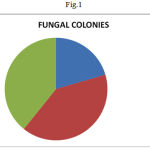Manuscript accepted on :April 28, 2010
Published online on: 24-11-2015
Plagiarism Check: Yes
Rita Shabnam Luka2 and Kavita Sharma1
1Arts and Commerce Girls College, Raipur India.
2Government Bilasa Girl’s P.G. College Bilaspur India.
Abstract
Aeromycoflora of Bilaspur city was studied during March 2009 to Feb 2010. Total 1760 fungal spores represented 21 fungal types were observed during the present investigation period. Cladosporium oxysporum showed the maximum percentage contribution of aero-mycoflora with the percentage of (14.09%), was followed by Alternaria alternata (10%). Both Trichoderma sp. (1.07%) and Bispora sp.(1.25%) showed the minimum percentage contribution of aero mycoflora were observed. Higher concentration of spores was observed during August (263) and lower concentration in the month of April(80). Out of total flora Aspergillus sp, Cladosporium sp., Curvularia sp and Aspergillus niger are allergenic in nature.
Keywords
Aeromycoflora; Fungal Sporas; Concentration
Download this article as:| Copy the following to cite this article: Luka R. S, Sharma K. Spore Calendar of Bilaspur City with Special Reference to Allergy. Biomed Pharmacol J 2010;3(1) |
| Copy the following to cite this URL: Luka R. S, Sharma K. Spore Calendar of Bilaspur City with Special Reference to Allergy. Biomed Pharmacol J 2010;3(1). Available from: http://biomedpharmajournal.org/?p=1480 |
Introduction
A great variety of fields are represented under the umbrella of aerobiology, including plant, human and animal pathology, entomology, air pollution effects, palynology, phytogeography and meteorology . Aerobiology is the study of airborne biological material, chiefly pollens and spores and their transport on other ogranisms. Microorganisms always present in the nature and they migrate through one place to another by air current. Fungus is the common microorganisms in our environment, and always present in form of spores. Airborne dusts containing fungal spores are associated with a range of respiratory diseases. The study of airborne fungal spores enables their occurrence to be related to the incidence of respiratory symptoms in exposed individuals. The particulate materials considered important in aerobiology include smokes and dusts, radio nuclides, pesticides and the biological forms, bacteria, fungi, fragments and spores of algae, protozoa and fern spores, pollen, plant fragments, minute seeds, insects and other micro fauna.
Materials and Methods
During the present investigation gravity Petri plates methods was used for aeromycological survey of Bilaspur city . The survey conducted for one year March 2009 to Feb 2010 . Ten sterilized Petri plates containing PDA medium will expose for 5-10 minutes at different places of Bilaspur city at one meter height above the ground level. Then the Petri plates, brought into the laboratory and incubated at 26±10c. for seven days. At the end of the incubation period the percentage contribution and percentage frequency were assessed. At the end of incubation period the fungal colonies were counted, isolated and identified with the help of available literature. (Ellis, 1949 ; Barnett, 1969 ; Nagmani et al. 2006).
Results and Discussion
During the investigation period total 1760 fungal colonies belonging to 21 species from 13 genera were observed. Out of which 444 fungal colonies in summer, 628 in rainy & 688 in winter season were observed (Fig.1). Percentage frequency and percentage contribution were also observed during investigation period. Cladosporium oxysporum showed the maximum percentage contribution of aero-mycoflora with the percentage of (14.09%), was followed by Alternaria alternata (10%). Both Trichoderma sp. (1.07%) and Bispora sp.(1.25%) showed the minimum percentage contribution of aero mycoflora were observed (Table-1) Out of total flora Aspergillus sp, Cladosporium sp., Curvularia sp and Aspergillus niger are allergenic in nature.
. Aspergillus sp. was observed throughout the study period similar result was also reported by Tiwari et al. (2006). Anamorphic fungi recorded as the most contributed fungal group throughout the study period similar result also recorded by (Jadhav and Tiwari 1994; Tiwari et al. 2005).
 |
Figure 1 |
Table1: % Contribution Of Fungal Flora
| Serial number | Fungal Species obtained | Percentage contribution (%) |
| 1
2
|
Alternaria alternata
Aspergillus awamori |
10.00
1.42 |
| 3 | Aspergillus flavus | 3.52 |
| 4
5 |
A. fumigatus
A.japonicus |
6.47
1.98 |
| 6 | A. nidulans | 2.27 |
| 7 | A. niger | 9.94 |
| 8 | A. temari | 2.55 |
| 9 | Bispora sp. | 1.25 |
| 10 | Cladosporium oxysporum | 14.09 |
| 11
12 13 14 |
Curvularia lunata.
Curvularia clavata Drechslera sp. Fusarium sp. |
9.48
6.07 6.59 5.56 |
| 15 | Mucor sp. | 2.67 |
| 16
17 |
Mycelia sterilia (white)
Nigrospora sp. |
4.54
1.53 |
| 18 | Penicillium crysogenum | 4.26 |
| 19 | P. frequentaus | 1.81 |
| 20 | Rhizopus sp. | 2.84 |
| 21 | Trichoderma viride | 1.07 |
References
- Barnett, H.K. Illustrated genera of imperfect fungi.” Mins Burgss Pub. Co. Minneapolis, Minnesota. (1969)
- Ellis, M.B.Damitiaceous Hyphomycetes. Common Wealth Mycological Institute, London. (1949)
- Jadhav, S.K. and Tiwari, K.L. Aeromycoflora of Ravan Village. Indian Bot. Report. 1(1&2) P: 33-36. (1994)
- Nagamani, A., Kunwar, I.K. and Manoharachary, C. Handbook of Soil Fungi. I. K. International Pvt. Ltd. New Delhi (India) (2006)
- Tiwari, K.L., Jadhav, S.K. and Kunjam, S.R. Studies of aeromycoflora of Dairy area at Raipur (C.G.). Flora and Fauna. 11(2) P: 195-196. (2005)
- Verma K.S.,& George A.M Circadian periodicity studies of some fungi dominant in the atmosphere of Jabalpur. Ecol. 24:2:109-115. .(2002)







